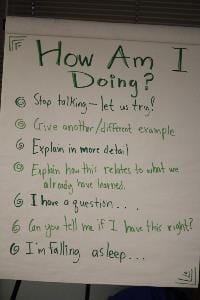I don’t know where I would be as a teacher—as a person—without having honest, specific (often painfully brutal) feedback from great mentors. Yet, perhaps even more powerful than feedback from my mentors has been the feedback I’ve received over the years from my students.
I’ll be honest—I amstill nervous every time I ask for feedback from the very people I hope to motivate, challenge, and inspire. Maybe it’s because my most common nightmares involve realizing that I’m teaching a terrible lesson—and that I’m suddenly naked (please tell me I’m not the only one who has those nightmares . . .).
But, no matter how badly I want to pee my pants every time I ask students for feedback, it has been worth the fear every time. And, through a lot of trial-and-error requesting feedback, I’ve learned a few mentalities and strategies that have made a critical difference.
Mentalities Worth Adopting
1. It’s not personal.
Adolescents aren’t the most tactful social group. Blame it on their still-developing prefrontal cortices or their cocktail of hormones. So, sometimes their feedback is a bit more biting than an adult’s would be.
In those moments when students write high-level feedback like, “You suck,” I have to remind myself not to take the abysmal ad hominem to heart—even when my inner-immaturity wants to kick in and say, “No! You suck . . . suck face!” Growth is not made through grudges.
This isn’t to say I should ignore it. Harsh comments like those are possibly a greater signal than any that I have some work to do in building a relationship with the student. If I don’t make an effort to seek to understand the why behind the comment, well then, the student was right; I do “suck.”
2. Humility is a pre-requisite for good teaching.
Teaching is our identity. We wear our profession with pride, often finding ways to bring it up whenever we can (especially for discounts). Sometimes, though, pride can be our downfall as any suggestion for improvement becomes a personal hit. I have to give myself permission to know that when I fail—which I will—it as an extension of what I did, not who I am.
I dropped my pride when I realized that the best teachers I know—whether they had been teaching for three years or thirty—were the ones asking for feedback from everyone and accepting it without a flinch.
3. Cut the “but.”
I found myself sabotaging my own willingness to adopt feedback by qualifying (or “disqualifying”) my responses with a “but” or “however.”
For example:
“I agree that I need to work more on organization and having a clear flow to our lesson. But, you’ll need to learn to be flexible in life, so it’s really not that big of a deal.”
“I can see where this student is coming from with that feedback, but they don’t have a Master’s degree in education. I do.”
“You’re right: That joke I made may have crossed the line. However, we’ve joked a lot in the past and it hasn’t been an issue.”
“I know many of you think learning about pronoun-antecedent agreement is boring. But, I have to teach it because it’ll be on the state test.”
Ultimately, these “disqualifiers” model an external locus of control. They are corrosive habits of:
- Justification – Saying the behavior is “okay” or excusable because . . .;
- Blame – Passing the root behavior onto some other person or thing;
- Denial – Discrediting that something is an important issue (or assuming it’s not there).
If I’m not going to take internal locus of control of my teaching, I might as well quit and let the robots do the teaching.
Strategies Worth Trying
1. Give students time and direction to prepare their feedback.
We sometimes assume that students spend their time in our classrooms critiquing our pedagogical finesse—that they dream about educational instruction (more likely, they are having nightmares of failing our lessons . . . and being naked in the process).
Sure, they are subtweeting about us or talking with their peers about what we do to annoy them, but this isn’t the same as pointed, detailed feedback. That’s why it’s so important to give them time for a genuine reflection.
When:
- Before a teacher-student conference: Tell students ahead of time that you will be asking them for honest feedback when you meet with them. Ask for it at the end of a writing or grade-check conference in which you are providing feedback. Asking for your own feedback beforehand may make students hesitant that sharing will influence your evaluation of their work.
- After class: At the beginning of a class, hand students slips of paper with prompts for specific feedback. Inform them that they can write you feedback at any point during class. Have students drop off their feedback in a box before leaving class.
And remember to use specific prompts. I’ve benefitted from asking specific questions like:
- What’s one thing I should keep doing [during instruction, when giving directions, etc.]?
- What’s one thing I should stop doing [. . .]?
- What’s one thing I should do differently [. . .]?
- What’s the most annoying thing I do [when lecturing, when assigning homework, etc.]?
- What’s the best thing I do to help you learn [. . .]?
- What could I do to give you better feedback [on your writing, on your quizzes, etc.]?
- What did you like about the assignment I gave last night?
- What did you dislike about the assignment I gave last night?
- “When you ________________________, I usually stop paying attention.”
- “I’ve heard other students express frustration about ____________________ with your teaching.”
2. Establish a “How am I doing?” habit.
In-the-moment feedback can also be extremely valuable. Try pausing a lesson and asking students, “How am I doing?” Tell them they can give you feedback on specifics (e.g., presenting information more clearly, talking less, explaining more, giving examples). Make this a habit so it doesn’t feel awkward. The stronger your trust and relationships are with students, the more likely you will get frequent (and authentic) feedback.
Create a classroom chart that lists common feedback responses so students have options when you ask.

Also, be ready to adapt based on the feedback. If they want more examples, be prepared with examples ahead of time.
3. Set up an accountability committee.
Put together a group of students that can give you feedback directly. Meet with them periodically after class to discuss feedback they have (bribing with food is always a great way to get kids to stay after class). Better yet, empower them to gather feedback from their classmates. Be cautious that the committee doesn’t have the impression of being a “favorites club,” or that it is exclusive. Gather an eclectic group of students and rotate the contributors often.
4. Try Feedback Fridays.
Build traditions for feedback in order to normalize the process (and not allow for excuses to “put it on the back burner”) Set aside a specific time each week for quick feedback. For me, Fridays have been a nice way to end off the week and have the weekend to mull over student feedback.
We often give students feedback with weekly grade-posting. Why not get feedback during these times as well?
5. Model your path to improvement.
Be open about what you are working to improve – and how it’s going. Consider posting one thing that you are working on for the week. Admit when things aren’t going well and what you are learning from the mistake. One of the biggest frustrations students have is the feeling of a “double-standard”: We expect them to grow and change daily, yet we often don’t model growth and change ourselves. When we own our own growth we move from assuming we are masters to ascending into models.

